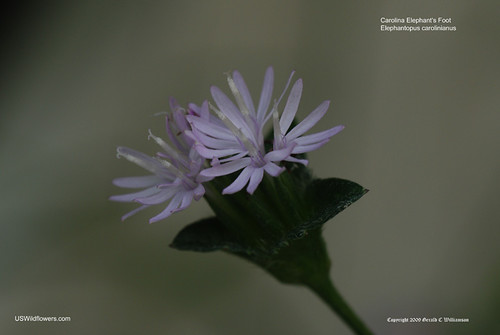Carolina Elephant’s Foot – Native Plant of the Day 11/03/2024
Photo from 9/25/2009. Location: Walker County, GA.
More photos / info at the Elephantopus carolinianus detail page.
Also NPOD 10/01/2012, 10/01/2013, 10/01/2014, 10/01/2015, 09/24/2016, 09/24/2016, 09/24/2017, 09/24/2018, 09/24/2019, 09/24/2020, 09/24/2021, 09/24/2022, 11/03/2023


Hello,
I found this flower near a power line road last summer & decided to plant it in my flower box in front of my nature center since it was going to be mowed over. Today I have found several love bugs drinking nectar from it. I’ve never seen that before & am pretty amazed to discover that they are a pollinator for this flower.
Just noticed quite a population of this plant along a moist area of our community bridle path here in the Northern Virginia Piedmont. Not in my old Peterson Guide to Wildflowers. Therefore super hard for me to identify. I spread moist area wildflower seeds this spring. Maybe they come from that. Cluster of small, lavender, aster-like flowers set at junction of three leaves. Blooming now.
Saw this on a recreational walk along a secondary road. I was amazed at the name. Would like to know the reason for calling it “elephant’s food.” Absolutely amazing wildflower. Thank you fro this page.
Sorry, “elephant’s foot”
Good question, Esta. Apparently the basal leaves of the original species in the genus had a shape that reminded the botanist who named it of an elephant’s foot.
I had these show up in the edge of my garden. I was hoping they were an herb. Apparently not. I live in southern Virginia in Mecklenburg county about 3 miles from the NC state line.
We live in N Fauquier County and have a fair bit of this lovely native growing happily on our property. Took a long time to ID it as it is not listed in either Peterson or Newcomb’s. Wonder why not.
I have been told by a grower of wildflowers that the seeds need winter chill to germinate, so don’t save seed indoors and plant it in the spring. You will be disappointed.
I really appreciate the careful description of how and why this flower is an asteracae on the detail page:
https://uswildflowers.com/detail.php?SName=Elephantopus%20carolinianus
Like the others, I found it hard to identify. It is way to beautiful to be so under-recognized.
Thank you
John